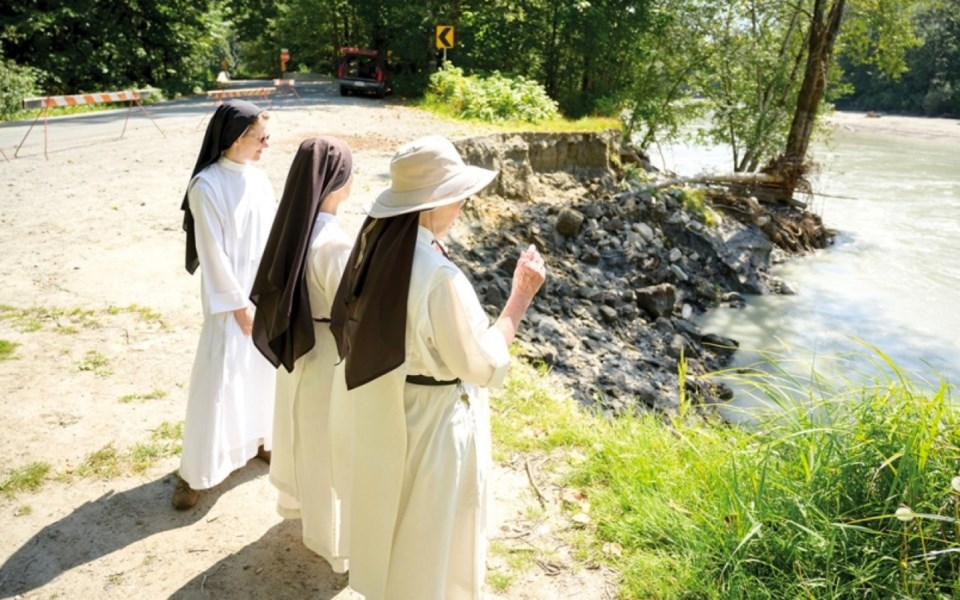To get in or out
of the Upper Squamish Valley, there is only one single-lane bridge — and residents say the next flood could make it collapse.At the latest Squamish-Lillooet Regional District board meeting on July 24, a letter from the nuns of the Queen of Peace Monastery in the Upper Squamish Valley said, "We beg you to engage in preventing this calamity."
Although the letter is dated from April, the past week's rains have been a major concern for the nuns and other residents of the area. The recent weather has caused the Squamish River to back up the Pilchuck Creek, and a tree is directing the water to the erosion, Sister Claire Rolf told The Chief.
"People are being very cautious as they go by," she said. "It would be a terrible tragedy. We weren't expecting big rains until the fall. We thought we'd get through the summer, but this big rain certainly had us worried."
These concerns are not new to those familiar with the upper valley. A flood mapping hazard report presented in the Squamish Valley in January did not include mitigation measures, much to the concern of the residents who attended. At the January presentation, some compared the Pilchuck Bridge to the Rutherford Creek Bridge near Pemberton, which killed four people in 2003 when a rainstorm washed the structure away.
SLRD board chair and Electoral Area D director Tony Rainbow told The Chief that "the Pilchuck River is undercutting the bank alongside the road, right by the bridge. If it's left unchecked, it eventually will wash the bridge out. The worry is that it could happen suddenly. If there were a storm and the right kind of winds and the water was high — if those things combined — it could sort of happen within a couple of hours. There's a concern that there could be an injury, there could be loss of life. Now that's a little dramatic — that's a bit the far end of the scale," Rainbow said.
"The greater concern, I guess, is that if that bridge is washed out, it cuts off all the people in the valley from Squamish."
Rainbow said there is a route that could be arranged through private land, where there is now a gated road, but it would be difficult. Logging trucks that frequently use Pilchuck Bridge would not be able to use this private link, Rainbow said, adding that is an economic consideration.
It's not just the residents who would be impacted, but the industry and increasing recreational tourism in the area.
Pilchuck Creek is also the boundary between the Squamish Nation Reserve and Upper Squamish Valley — meaning one side of the bridge is on Nation land.
Rainbow sees the bridge as an opportunity to put reconciliation into action. At the July 24 board meeting, the SLRD voted to contact the Squamish Nation about the bridge and to write to the Ministry of Transportation and Infrastructure (MOTI), to ask for immediate action to create a plan to deal with the situation before it becomes an emergency.
Rainbow's report to the SLRD board said MOTI is "well aware of the increasing erosion of the banks by the bridge."
After the meeting, Rainbow told The Chief "The Ministry of Transport, their attitude seems to be we don't have a budget to do anything about it right now, but if it does wash out we could have access to emergency funds to fix it. Our view at this point is that's not a good enough answer. We need to find a way of fixing it now."
Rainbow said the SLRD board wants residents to know its members are listening to their concerns and taking action. Of the letter from the sisters of the monastery, Rainbow said, "Quite frankly, when I got that, I thought, 'My goodness, if they are being moved to political action, then it's about time the SLRD did more than we have been doing.' It gave us a bit of a jump start."
The nuns of the monastery gathered to add their voices and call attention to the danger, all of them signing the letter to the government, Rolf said.
"Our concern is for the lives of people," the sister said. "What is the price on people's lives? That is how people have died in the past."
This article originally appeared here.




